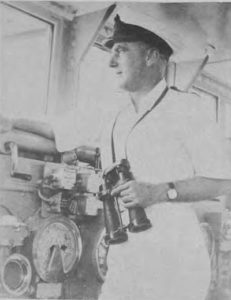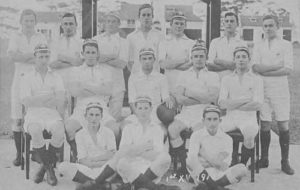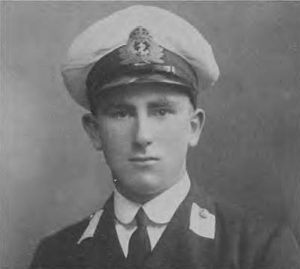- Author
- Burnett, Cdr. P.R. RAN (Ret.)
- Subjects
- Biographies and personal histories
- Tags
-
- RAN Ships
- HMAS Adelaide I, HMAS Canberra I, HMAS Australia I, HMAS Sydney II
- Publication
- December 1973 edition of the Naval Historical Review (all rights reserved)

Captain Joseph Burnett was a product of an era in the Royal Australian Navy which is now legendary. A first entry to the Royal Australian Naval College, he obtained colours in rugby, cricket, tennis and athletic sports. His first ship was the Australian battle-cruiser HMAS Australia which he joined in the North Sea in 1917. His last ship was the second HMAS Sydney. He was commended by his superiors and respected by all who served under him. This is the story of Captain Burnett by his son, who followed his father’s footsteps in a naval career.
WHEN I WAS ASKED by the Committee of the Naval Historical Society to contribute an article on my father to the Review, I approached the task with some trepidation. He died when I was 13, and so my memories of him are childhood ones, notoriously unreliable. Moreover, although he kept comprehensive diaries, records and photograph albums, these were unfortunately all lost with him in HMAS Sydney, so that many of the usual sources of material for such an article are missing. However, with the help of his brother Dick Burnett and my mother, as well as Vice-Admiral Sir John Collins and other naval contemporaries and official naval records, I have been able to fill in the details of an otherwise sketchy picture, and I thank all those who have so kindly assisted me.

Joseph Burnett was born at Singleton, NSW on 26th December 1899, the second son of Richard and Emily Burnett (nee Adams) of Singleton. His grandfather William Burnett, a fascinating character, had emigrated to NSW from Cornwall in 1859 at the age of 24, and practised the trade of blacksmith and later building contractor in the growing colony. As a youngster Joe showed early academic and sporting ability at Singleton Primary School. His father had died when he was only seven, and the prospect of a free education as well as the glamour of the sea (which has attracted many another country boy before and since) probably led him to apply in 1913 for entry to the RAN College, just then being formed. He was selected1 and so became one of the first entrants, initially at Osborne House, Geelong and subsequently at Jervis Bay.
On graduating from the RANC in 1917, he joined the battle cruiser HMAS Australia with others of his term, and saw war service in the Atlantic until the end of the 1914-18 war. He spent most of the next seven years serving with the RN in the United Kingdom, being promoted to Lieutenant in 1920 and qualifying as a gunnery officer at Whale Island in 1922. During these years he made a name for himself as a rugby half and threequarter, representing the United Services, Hampshire and the Royal Navy, playing in the heyday of RN rugby fame outside Davies and Kershaw, the famous RN half combination who also played for England. Admiral Collins recalls seeing him play for the Navy against the Army at Twickenham. He was also outstanding at tennis, cricket and athletics. He played in the RN tennis championships at Wimbledon, and a plaque at the Garden Island tennis courts records that he won the RAN singles title two years running. He represented the RN College, Greenwich, at cricket and athletics and a number of trophies in the family’s possession bear witness to his ability.

In 1924 he was appointed gunnery officer of the cruiser HMAS Adelaide, then on a ‘showing the flag’ cruise round the British Isles, and the same year he married Enid (Jill) Ward of Waterlooville, Hampshire, and returned to Australia via the Far East. He spent the next three years in Australia, including two as gunnery officer at Flinders Naval Depot, and then in 1927 he went back to the United Kingdom to stand-by the County Class cruiser HMAS Canberra, then building at John Brown’s shipyard in Glasgow, where I was born in 1928, the year he became a Lieutenant Commander. He commissioned Canberra as gunnery officer and circumnavigated Australia ‘showing the flag’ in her. My brother Rory was born in 1929 and the following year my father again went to England, this time as squadron gunnery officer in the destroyer leader HMS Wallace.
After this appointment he remained to do the Naval Staff Course at the RN College, Greenwich, in 1932, where John Collins was a fellow student. He was promoted Commander in December of that year and in 1933 returned to Australia and served for two years at Navy Office at Victoria Barracks, Melbourne. While he was there he played an active part in putting on a Naval Pageant at the Melbourne Showgrounds at the end of 1934, produced by Captain Angus Nichol, RN. I remember being taken to see this show as a small boy of six and being greatly impressed by it. In later years I saw a copy of the programme and it was certainly an original, remarkable and entertaining performance. My mother and Admiral Becher have recalled some of the details for me. The opening number was a rousing chorus beginning ‘Good evening everybody, we probably look tough . . .’ and detailing the joys and tribulations of a naval life. One of the highlights was a series of skits sung to well known operatic arias, presented under the title ‘L’Appreziatione della Situatione.’ The lyrics gave a hilarious picture of an admiral and his staff who find in the heat of battle that their intentions are not understood.




